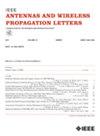用于Wi-Fi 7应用的非均匀超表面和蘑菇结构的紧凑型双频双极化天线
IF 4.8
2区 计算机科学
Q2 ENGINEERING, ELECTRICAL & ELECTRONIC
引用次数: 0
摘要
提出了一种尺寸紧凑、隔离度高的双频双极化天线,用于无线保真度(Wi-Fi) 7应用。它采用非均匀超表面和蘑菇结构作为双波段工作的主要辐射元件。利用超表面在上频段产生多个共振,这些共振也被加载蘑菇单元来产生下频段。散热器通过一个用于双极化辐射的交叉槽与两条正交微带线耦合。凹槽背面有金属腔,以减少背面辐射。最终设计的总体尺寸为$\text{0.48} \lambda _{L} \times \text{0.48} \lambda _{L} \times \text{0.075} \lambda _{L}$ ($\lambda _{L}$为2.37 GHz的自由空间波长),回波损耗带宽为2.37 GHz至2.50 GHz和5.02 GHz至7.15 GHz,为10 dB,隔离度为$\ge$ 23 dB。其工作带宽完全覆盖2.4 GHz/5 GHz/6 GHz Wi-Fi频段。此外,通过远场测量验证了双频双极化辐射,其交叉极化电平为$\leq -\text{20}$ dB,上下波段的峰值增益分别为5.2 dBi和10.7 dBi。本文章由计算机程序翻译,如有差异,请以英文原文为准。
A Compact Dual-Band Dual-Polarized Antenna Using Nonuniform Metasurface and Mushroom Structures for Wi-Fi 7 Applications
A dual-band dual-polarized antenna with compact size and high isolation is proposed for Wireless Fidelity (Wi-Fi) 7 applications. It employs a nonuniform metasurface and mushroom structures as the primary radiating elements for the dual-band operation. The metasurface is utilized for multiple resonances at the upper band, which are also loaded mushroom elements to generate the lower band. The radiators are coupled with two orthogonal microstrip lines through a crossed slot for the dual-polarized radiation. The slot is backed by a metallic cavity to reduce the back radiation. The final design with an overall size of $\text{0.48} \lambda _{L} \times \text{0.48} \lambda _{L} \times \text{0.075} \lambda _{L}$ $\lambda _{L}$ $\ge$ $\leq -\text{20}$
求助全文
通过发布文献求助,成功后即可免费获取论文全文。
去求助
来源期刊
CiteScore
8.00
自引率
9.50%
发文量
529
审稿时长
1.0 months
期刊介绍:
IEEE Antennas and Wireless Propagation Letters (AWP Letters) is devoted to the rapid electronic publication of short manuscripts in the technical areas of Antennas and Wireless Propagation. These are areas of competence for the IEEE Antennas and Propagation Society (AP-S). AWPL aims to be one of the "fastest" journals among IEEE publications. This means that for papers that are eventually accepted, it is intended that an author may expect his or her paper to appear in IEEE Xplore, on average, around two months after submission.

 求助内容:
求助内容: 应助结果提醒方式:
应助结果提醒方式:


